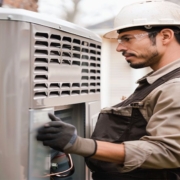What is the Length of AC?
Introduction
The length of an air conditioner (AC) refers to how long it operates to cool a space efficiently. Understanding the optimal size of AC operation is crucial for maintaining comfort, energy efficiency, and cost-effectiveness in any indoor environment.
Importance of AC Length
Efficiency of AC System
The length of time an AC operates directly impacts its efficiency. An AC that runs too long or too short a period may not effectively cool the space, leading to discomfort and potentially higher energy bills.
Impact on Energy Consumption
The length of AC operation significantly affects energy consumption. Overly long runtimes can result in unnecessary energy usage, while short cycles may cause the system to work harder, increasing energy consumption and wear and tear on the equipment.
Factors Affecting AC Length
Room Size
The size of the room plays a crucial role in determining the optimal length of AC operation. Larger spaces require more time for the air conditioner to cool adequately, while smaller rooms may reach the desired temperature more quickly.
Insulation
The level of insulation in a building affects how quickly it gains or loses heat. Well-insulated spaces retain cool air more effectively, reducing the need for prolonged AC operation.
Climate
The climate of the region also influences the length of AC operation. Hotter climates typically require longer cooling cycles, while milder climates may allow shorter runtimes.
Optimal AC Length
Determining the Right Size
Selecting the appropriate size of AC unit for space is essential for achieving optimal operation length. Oversized units may cool the space too quickly, leading to short cycles and uneven cooling, while undersized units may need to help maintain the desired temperature.
Calculating Cooling Load
Calculating the cooling load of a space helps determine the optimal AC size and runtime. Factors such as room size, insulation, occupancy, and heat-generating appliances contribute to the cooling load calculation.
Consequences of Incorrect AC Length
Overcooling
Excessive AC operation can lead to overcooling, causing discomfort and wasting energy. Overcooling also increases humidity levels, potentially leading to mould growth and indoor air quality issues.
Undercooling
Insufficient AC operation results in undercooling, leaving the space uncomfortably warm and increasing the workload on the system. Undercooling may also lead to moisture buildup and mould growth in humid climates.
Methods to Adjust AC Length
Programmable Thermostats
Programmable thermostats allow users to set specific temperature preferences and schedules, optimising AC operation for comfort and energy efficiency. By programming the thermostat to adjust temperature settings based on occupancy and time of day, users can reduce unnecessary AC runtime.
Zoning Systems
Zoning systems divide a building into separate zones, each with its thermostat and dampers to control airflow. This allows for more precise temperature control and reduces the need for the entire AC system to operate continuously.
Conclusion
The length of AC operation plays a critical role in maintaining indoor comfort, energy efficiency, and cost-effectiveness. Users can ensure efficient cooling while minimising energy consumption and costs by understanding the factors influencing AC length and implementing strategies to optimise operation.
FAQs
- How can I determine the right size of AC unit for my space?
- The right size of an AC unit depends on factors such as room size, insulation, climate, and cooling load. Consulting with a professional HVAC technician can help determine the appropriate size for your space.
- What is the ideal temperature setting for an AC unit?
- The ideal temperature setting varies depending on personal preference and external factors such as climate and humidity. Generally, setting the thermostat between 72-78°F (22-25°C) provides a comfortable balance between cooling and energy efficiency.
- What are some signs that my AC unit is running for too long?
- Signs that your AC unit may be running for too long include excessive cycling, uneven cooling, high humidity levels, and increased energy bills. If you notice any of these signs, it’s essential to have your AC system inspected by a professional.
- How can I improve the efficiency of my AC unit?
- Improving the efficiency of your AC unit involves regular maintenance, such as cleaning or replacing air filters, sealing ducts, and scheduling professional tune-ups. Additionally, using programmable thermostats and implementing energy-saving practices can help reduce energy consumption.
- Can I install an AC unit myself?
- While it’s possible to install a window AC unit yourself, installing a central AC system typically requires professional installation to ensure proper sizing, placement, and functionality.

